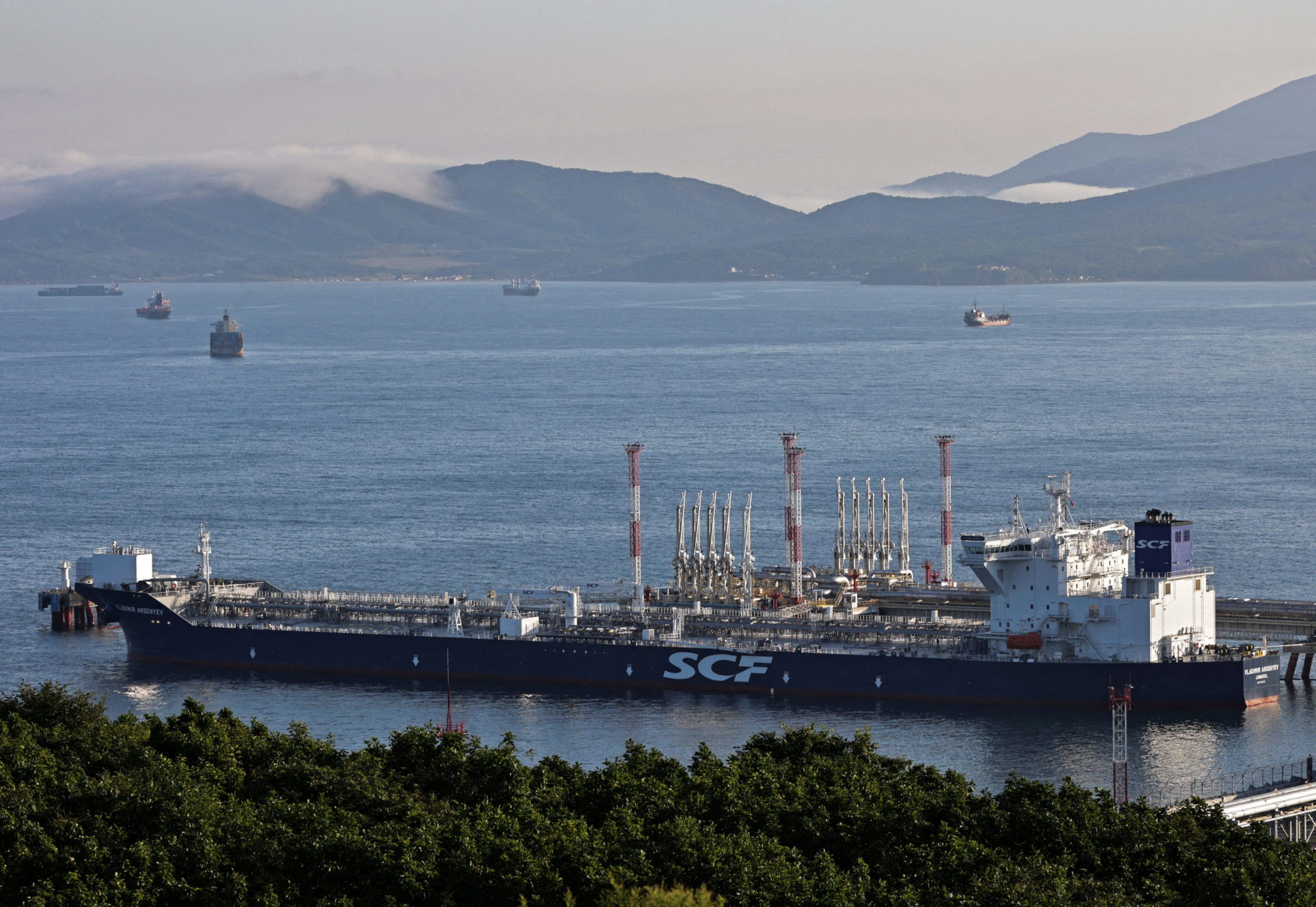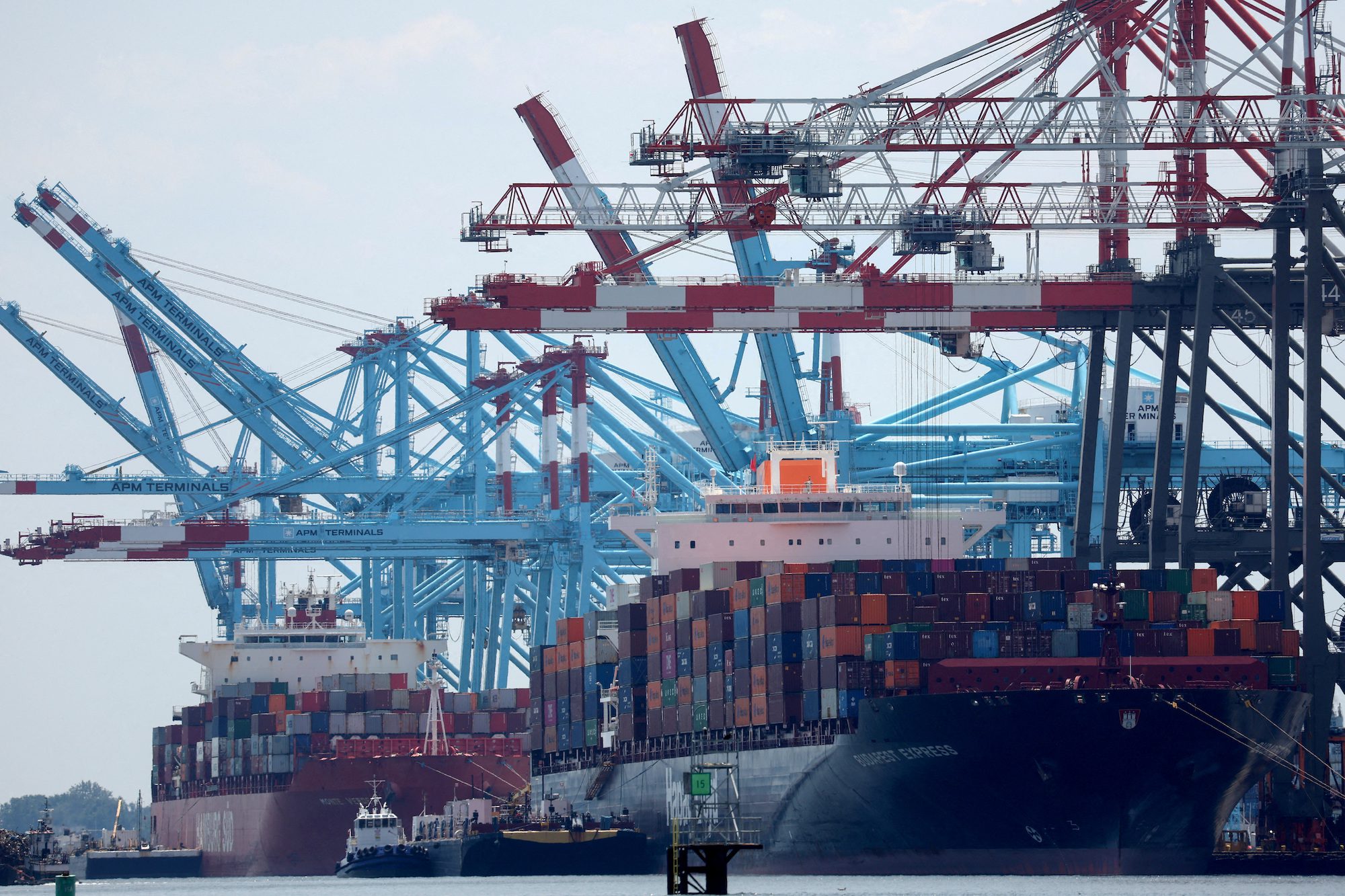(Bloomberg) —
Russia’s seaborne crude flows fell to their lowest since January after an unexplained slowdown at the Black Sea port of Novorossiysk, while the nation pledges to restrict its oil exports.
Average nationwide shipments in the four weeks to Aug. 20 dropped to 2.84 million barrels a day, tanker-tracking data compiled by Bloomberg show. That’s about about 1.05 million barrels a day below the peak in mid-May. More volatile weekly numbers also fell sharply, dropping to their lowest since December.
The amount of Russian crude loaded at Novorossiysk equaled the lowest volume seen since Moscow’s troops invaded Ukraine in February 2022. Shipments fell behind the scheduled program last week, with two gale warnings issued for the area around the port. It does not appear that flows have been affected by Ukraine’s drone attacks on two Russian vessels in the northeastern Black Sea earlier this month, which briefly halted activity at port at the time.
Weekly data are affected by the scheduling of tankers and loading delays caused by bad weather. Port and pipeline maintenance can also disrupt exports for several days at a time. Weekly shipments dropped by 420,000 barrels a day in the week to Aug. 20 to average 2.37 million barrels a day. The less volatile four-week average was down by about 90,000 barrels a day.
The figures support the notion that Moscow is now honoring a pledge to keep supply off the global market alongside its allies in the OPEC+ producer coalition. Russia initially said it would cut oil production in retaliation for Western sanctions and price caps on its oil imposed after the invasion of Ukraine, using February 2023 figures as a baseline. But seaborne flows had continued to rise, dropping significantly only in the last few weeks.
Moscow’s initial commitment to cut production by 500,000 barrels a day in March had no immediate effect on exports. Flows from western ports actually rose, peaking in late May. The subsequent reduction came after fellow OPEC+ oil producer Saudi Arabia made and then extended its own unilateral output cut, putting pressure on Russia to implement its own reduction.
Moscow eventually followed through on its pledge, with flows from western ports now down by about 420,000 barrels a day from their average February level. Flows from the Baltic and Black Seas have fallen in eight of the past nine weeks.
Russia will extend its export cut into September, Deputy Prime Minister Alexander Novak said earlier this month, following a similar announcement from Saudi Arabia. However, the size of the supply reduction will be tapered to 300,000 barrels a day, from 500,000 barrels a day in August. Russia has given no baseline from which the export cut is to be measured.
The latest drop in overseas flows comes as Russia’s oil refineries increased crude-processing rates in the first half of August — before a sharp cut to state subsidies that’s about to take effect in September. The rise also comes ahead of the next maintenance season, with several refineries due to start work this month.
Crude Flows by Destination
Russia’s seaborne crude flows are now at a lower level than they’ve been for most of this year. It was only in the second half of June that shipments began to fall significantly.
With few buyers left in Europe, the impact is being felt in shipments to Asia. On a four-week average basis, overall seaborne exports to Asian countries — plus the volumes on ships showing no final destination — are now more than 1 million barrels a day below their peak in mid-May. Flows to the region in the most recent period were the lowest since the four weeks to Jan. 8.
All figures exclude cargoes identified as Kazakhstan’s KEBCO grade. Those are shipments made by KazTransoil JSC that transit Russia for export through Novorossiysk and the Baltic port of Ust-Luga.
The Kazakh barrels are blended with crude of Russian origin to create a uniform export grade. Since Russia’s invasion of Ukraine, Kazakhstan has rebranded its cargoes to distinguish them from those shipped by Russian companies. Transit crude is specifically exempted from European Union sanctions.
Asia
Observed shipments to Russia’s Asian customers, including those showing no final destination, fell to 2.51 million barrels a day in the four weeks to Aug. 20, from 2.63 million barrels a day in the period to Aug. 13.
Most of the cargoes on ships without an initial destination eventually end up in India. Even so, the volumes heading to the country that has become the biggest buyer of Russia’s seaborne crude are down from their recent highs. Adding the “Unknown Asia” and “Other Unknown” volumes to the total for India gives a figure of 1.52 million barrels a day in the four weeks to Aug. 20, down from a high of 2.15 million barrels a day in the period to May 21.
The equivalent of 290,000 barrels a day was on vessels signaling Port Said or Suez in Egypt, or which already have been or are expected to be transferred from one ship to another off the South Korean port of Yeosu. Those voyages typically end at ports in India or China and show up in the chart below as “Unknown Asia” until a final destination becomes apparent.
The “Other Unknown” volumes, running at 56,000 barrels a day in the four weeks to Aug. 20, are those on tankers showing no clear destination. Most of those cargoes originate from Russia’s western ports and go on to transit the Suez Canal, but some could end up in Turkey. Others could be transferred from one vessel to another, either in the Mediterranean or, more recently, in the Atlantic Ocean.
Europe
Russia’s seaborne crude exports to European countries were unchanged at 125,000 barrels a day in the 28 days to Aug. 20, with Bulgaria the sole destination. These figures do not include shipments to Turkey.
A market that consumed about 1.5 million barrels a day of short-haul seaborne crude, coming from export terminals in the Baltic, Black Sea and Arctic has been lost almost completely, to be replaced by long-haul destinations in Asia that are much more costly and time-consuming to serve.
No Russian crude was shipped to northern European countries in the four weeks to Aug. 20.
Exports to Turkey, Russia’s only remaining Mediterranean customer, rose to about 167,000 barrels a day in the four weeks to Aug. 20. Flows to the country had topped 425,000 barrels a day in October.
Flows to Bulgaria, now Russia’s only Black Sea market for crude, have stabilized at 125,000 barrels a day. That’s about twice as much as the country was importing at the lowest points between March and May.
Flows by Export Location
Aggregate flows of Russian crude slumped to 2.37 million barrels a day in the seven days to Aug. 20, down from 2.79 million barrels a day the previous week. The drop came entirely from Russia’s western ports, with shipments from the Pacific rebounding above 1 million barrels a day.
A sharp drop in the volume of crude leaving Novorossiysk in the week to Aug. 20 appears unplanned, with flows falling behind the loading program over the course of the week.
Figures exclude volumes from Ust-Luga and Novorossiysk identified as Kazakhstan’s KEBCO grade.
Vessel-tracking data are cross-checked against port agent reports as well as flows and ship movements reported by other information providers including Kpler SAS and Vortexa Ltd.
Export Revenue
Inflows to the Kremlin’s war chest from its crude-export duty fell to $38 million in the seven days to Aug. 20, a decrease of $7 million or 15%. Four-week average income slipped to almost $46 million.
Russia’s government calculates oil taxes — including export duty — using a discount to global benchmark Brent, which sets the floor price for the nation’s crude for budget purposes. If Russian oil trades above that threshold, the Finance Ministry uses the market price for tax calculations, as has been the case in recent months. The discount used to calculate taxes including export duty is set at $25 a barrel for July and August, but will narrow to $20 a barrel from September.
The duty rate for August has been set at $2.31 a barrel, based on an average Urals price of $58.03 during the calculation period between June 15 and July 14. That was $18.02 a barrel below Brent during the same dates.
For September, the duty has been set at $2.92 a barrel, based on an average Urals price of $70.33 during the calculation period between July 15 and Aug. 14. That was $13.90 a barrel below Brent over the same period. September’s duty rate is the highest this year.
Origin-to-Location Flows
The following charts show the number of ships leaving each export terminal and the destinations of crude cargoes from the four export regions.
A total of 23 tankers loaded 16.6 million barrels of Russian crude in the week to Aug. 20, vessel-tracking data and port agent reports show. That’s down by 2.94 million barrels from the previous week’s figure and the smallest figure since December.
Shipments from Novorossiysk slumped, with just one cargo of Russian crude loading at the Black Sea port during the week.
Flows from other western regions also fell, with only the Pacific region showing a week on week increase, with exports rebounding above 1 million barrels a day.
Destinations are based on where vessels signal they are heading at the time of writing, and some will almost certainly change as voyages progress. All figures exclude cargoes identified as Kazakhstan’s KEBCO grade.
The total volume on ships loading Russian crude from the Baltic terminals continued to fall, dropping below 1 million barrels a day for only the second time this year to equal its lowest level since December. One cargo of Kazakhstani crude was loaded at Ust-Luga during the week. Shipments from the Baltic are down by about 830,000 barrels a day from the highs seen between April and June.
Shipments of Russian crude from Novorossiysk slumped to their lowest since December, with just one tanker loading Russian crude. Shipments were running in line with the loading program for the port at the start of the week, but had fallen several days behind by the end.
One cargo of Kazakhstani crude was also loaded at the port during the week.
Two Suezmax tankers completed loading cargoes at the Arctic port of Murmansk in the week to Aug. 20, leaving flows down week on week, but broadly in line with their average level so far this year.
One tanker that loaded in the week to Aug. 13 is headed to Ghana, where it’s due to arrive later this month. A previous cargo, loaded at Novorossiysk in January, discharged in the West African nation after a six-week wait off the port of Tema.
Eleven tankers loaded at Russia’s three Pacific export terminals, unchanged from the previous week. The volume of crude shipped from the region rose to 1.06 million barrels a day, due to larger cargo sizes.
Shipments from the Sakhalin Island terminal continue to be affected by maintenance at one of the Sakhalin 2 project’s oil production platforms. The work is set to run until September. One vessel loaded a part cargo of Sakhalin Blend crude from the terminal.
The volumes heading to unknown destinations are mostly Sokol cargoes that recently have been transferred to other vessels at Yeosu, or are currently being shuttled to an area off the South Korean port from the loading terminal at De Kastri. Most of these are ending up in India. The destination of the part-loaded cargo of Sakhalin Blend is also unknown, but previous cargoes have all headed to China.
Some Sokol cargoes are now being transferred a second time in the waters off southern Malaysia. A small number of ESPO shipments are also being moved from one vessel to another in the same area. All bar one of these cargoes have, so far, gone on to India. That one cargo was transferred onto a floating storage vessel off Malaysia. It was then transferred onto another tanker, which was showing a destination in China while anchored off Johor, to the east of Singapore. That ship’s draft suggests the cargo has been offloaded into an unidentified tanker.
Shipments of Sokol crude to India have picked up again after slumping to zero in June. Flows in July averaged about 140,000 barrels a day and at least two cargoes are heading there this month.
–With assistance from Sherry Su.
© 2023 Bloomberg L.P.

 Join The Club
Join The Club











